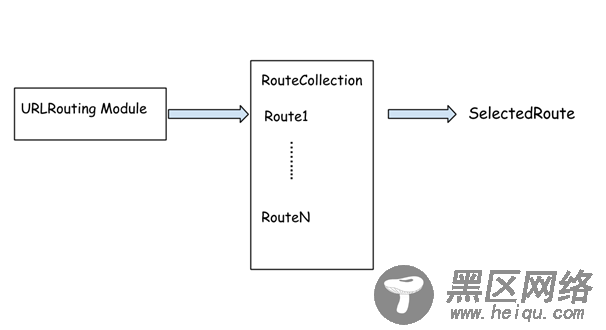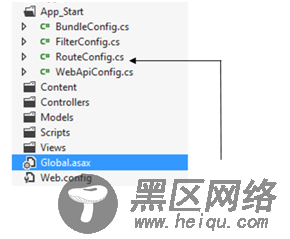这一步至关重要哈,看到没有,就是对我们在HttpApplication那19个事件中的PostResolveRequestCache事件的注册。注册的方法是OnApplicationPostResolveRequestCache事件。也就是说HttpApplication对象在执行到PostResolveRequestCache这个事件的时候,就会执行OnApplicationPostResolveRequestCache事件。决定是MVC机制处理请求的关键所在就是OnApplicationPostResolveRequestCache事件。
从源码中我们看出,OnApplicationPostResolveRequestCache事件执行的时候,最终执行了PostResolveRequestCache这个方法。最关键的地方呢就在这里了。
当请求到达UrlRoutingModule的时候,UrlRoutingModule取出请求中的Controller、Action等RouteData信息,与路由表中的所有规则进行匹配,若匹配,把请求交给IRouteHandler,即MVCRouteHandler。我们可以看下UrlRoutingModule的源码来看看,以下是几句核心的代码:
我们再分析一下这个方法的源码:
public virtual void PostResolveRequestCache(HttpContextBase context) { // 通过RouteCollection的静态方法GetRouteData获取到封装路由信息的RouteData实例 RouteData routeData = this.RouteCollection.GetRouteData(context); if (routeData != null) { // 再从RouteData中获取MVCRouteHandler IRouteHandler routeHandler = routeData.RouteHandler; ...... if (!(routeHandler is StopRoutingHandler)) { ...... // 调用 IRouteHandler.GetHttpHandler(),获取的IHttpHandler 类型实例,它是由 IRouteHandler.GetHttpHandler获取的,这个得去MVC的源码里看 IHttpHandler httpHandler = routeHandler.GetHttpHandler(requestContext); ...... // 合适条件下,把之前将获取的IHttpHandler 类型实例 映射到IIS HTTP处理管道中 context.RemapHandler(httpHandler); } } }
看到了吧,通过路由规则,返回的不为空,说明匹配正确,关于路由规则的匹配,说起来也不短,这里就不大幅介绍,有时间下次再开篇详解路由机制。匹配成功后,返回一个RouteData类型的对象,RouteData对象都有些什么属性呢?看看这行源码: IRouteHandler routeHandler = routeData.RouteHandler;或者看源码我们知道,RouteDate有一个RouteHandler属性。

那么UrlRouting Module是如何选择匹配规则的呢?

我们看看我们新建的MVC应用程序,在App_Start文件夹下面有一个RouteConfig.cs类,这个类的内容如下:
using System; using System.Collections.Generic; using System.Linq; using System.Web; using System.Web.Mvc; using System.Web.Routing; namespace ApiDemo { public class RouteConfig { public static void RegisterRoutes(RouteCollection routes) { routes.IgnoreRoute("{resource}.axd/{*pathInfo}"); routes.MapRoute( name: "Default", url: "{controller}/{action}/{id}", defaults: new { controller = "Home", action = "Index", id = UrlParameter.Optional } ); } } }
我们在这个类里面,主要是给路由表添加路由规则。在看看上面的UrlRoutingModule类,里面有一个RoutCollection属性,所以UrlRoutingModule能够获取路由表中的所有规则,这里值得注意的是,路由规则的匹配是有顺序的,如果有多个规则都能够匹配,UrlRoutingModule至选择第一个匹配的规则就返回,不再继续往下匹配了。相反的如果一个请求,没有匹配到任何路由,那么该请求就不会被处理。
这里返回的RouteData里的RouteHandler就是MVCRouteHandler。为什么呢?那我们继续往下看RouteHandler。
RouteHandler
生成MvcHander
在上面路由匹配的过程中,与匹配路由相关联的MvcRouteHandler ,MvcRouteHandler 实现了IRouteHandler 接口。MvcRouteHandler 主要是用来获取对MvcHandler的引用。MvcHandler实现了IhttpHandler接口。
MVCRouteHandler的作用是用来生成实现IHttpHandler接口的MvcHandler。而我们前面说过最终处理请求的都是相对应的HttpHandler。那么处理MVC请求的自然就是这个MvcHandler。所以这里返回MvcRouteHandler至关重要:
那么,MvcRouteHandler从何而来呢?众所周知,ASP.NET MVC项目启动是从Global中的Application_Start()方法开始的,那就去看看它:
public class MvcApplication : System.Web.HttpApplication { protected void Application_Start() { RouteConfig.RegisterRoutes(RouteTable.Routes); BundleConfig.RegisterBundles(BundleTable.Bundles); } } public class RouteConfig { public static void RegisterRoutes(RouteCollection routes) { routes.IgnoreRoute("{resource}.axd/{*pathInfo}"); System.Web.Mvc.RouteCollectionExtensions routes.MapRoute( name: "Default", url: "{controller}/{action}/{id}", defaults: new { controller = "Home", action = "Index", id = UrlParameter.Optional } ); } }
看看我上面标红的代码:这是路由注册,玄机就在这里。那我们去看看MapRoute源码就知道咯:
